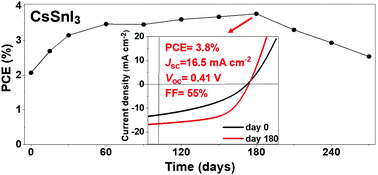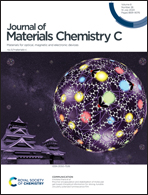An inorganic stable Sn-based perovskite film with regulated nucleation for solar cell application†
Abstract
The tin (Sn)-based halide perovskites have attracted tremendous attention as a lead-free alternative in halide perovskite solar cells (PSCs). Inorganic cesium tin triiodide (CsSnI3) provides a promising solution to solve the poor thermal stability of Sn-based halide perovskite. However, CsSnI3-based PSCs suffer from intrinsic defects such as the easy Sn2+/Sn4+ oxidation and the unbalanced rates between crystal nucleation and growth during film fabrication, leading to an inferior performance. Herein, a vacuum flash-assisted solution processing (VASP) method is utilized to fabricate a high-quality CsSnI3 film for the first time. Compared with the CsSnI3 film fabricated by the spin-coating route, the VASP CsSnI3 film shows an increased surface coverage, enhanced charge carrier mobility, improved film stability, and reduced background charge carrier density. These changes in turn facilitate the charge carrier transport and reduce the trap-assisted recombination in the VASP PSCs. As a consequence, the VASP PSCs show greatly improved efficiency. Moreover, the VASP PSCs show a continuously increasing efficiency as a function of storage time. After they are stored for 180 days, a PCE of 3.8% is achieved, which is also one of the state-of-the-art performances for inorganic CsSnI3-based PSCs.



 Please wait while we load your content...
Please wait while we load your content...